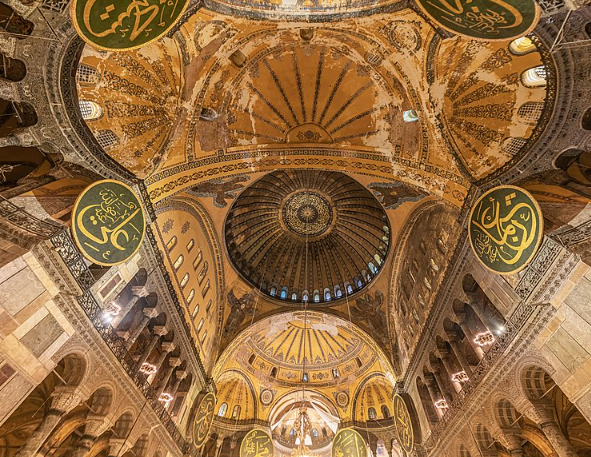Hagia Sophia: A 1600-Year History Of Survival

Table of Contents
From Basilica to Mosque: A Change in Religious Significance
The Hagia Sophia's existence reflects a fascinating interplay of religious and political power. Its journey from a Christian basilica to a Muslim mosque, and finally to a secular museum, showcases the shifting tides of history and the enduring power of this remarkable building.
The Byzantine Era (532-1453 AD):
Construction of the Hagia Sophia, commissioned by Byzantine Emperor Justinian I, began in 532 AD. The architectural innovations of Anthemius of Tralles and Isidore of Miletus were revolutionary. Their use of pendentives – curved triangular sections of masonry – allowed for the creation of a vast, unsupported dome, a feat unparalleled at the time. This Hagia Sophia architecture influenced countless structures throughout history. The Byzantine Hagia Sophia served as the center for Eastern Orthodox Christianity, hosting lavish ceremonies and solidifying the emperor's power.
- Architectural Marvels: The immense dome, soaring to a height of 180 feet, was a symbol of Byzantine power and technological prowess.
- Religious Center: The Hagia Sophia was not merely a building; it was the spiritual heart of the Byzantine Empire, a place of immense religious and political significance.
- Imperial Power: Imperial ceremonies, religious services, and political gatherings cemented its status as the center of the Byzantine world.
The Ottoman Era (1453-1931 AD):
The Ottoman conquest of Constantinople in 1453 marked a dramatic turning point. The Hagia Sophia, immediately converted into a mosque, underwent significant modifications under the Ottoman sultans. The addition of four minarets, a mihrab (prayer niche), and a mimbar (pulpit) reflected its new religious purpose. The Hagia Sophia mosque became a central place of worship for the Muslim community, its grandeur adapting to a new faith. Despite the changes, Ottoman rulers also undertook preservation efforts, demonstrating a respect for the building's historical importance.
- Architectural Adaptations: The Ottoman modifications respected the existing structure while integrating Islamic architectural elements.
- Religious Significance: The Hagia Sophia mosque became a crucial center for Islamic worship in Istanbul, representing the shift in religious dominance in the city.
- Ottoman Preservation: The Ottomans, despite altering the Hagia Sophia, actively worked to maintain and preserve the structure, showcasing their own appreciation of architectural legacy.
The Modern Era (1931-Present):
In 1931, under the newly established Turkish Republic, the Hagia Sophia was secularized and transformed into a museum. This momentous decision reflected the country's embrace of secularism and its aim to create a shared cultural heritage, accessible to people regardless of their religious beliefs. However, the Hagia Sophia museum's status remains a subject of ongoing debate and occasional controversy, highlighting the complex political and religious currents that surround this iconic building. The recent decision to re-designate it as a mosque and its subsequent reversal again exemplify the complex history and modern significance of the Hagia Sophia today.
- Museum Status: The conversion into a museum aimed to make the Hagia Sophia accessible to a global audience as a monument of human achievement.
- Ongoing Debates: The Hagia Sophia's designation continues to be debated, reflecting its deep religious and political significance for both Christianity and Islam.
- Political Implications: The political implications associated with the building's religious status highlight its continued importance as a symbol of cultural and national identity.
Architectural Marvels and Engineering Innovations
The Hagia Sophia's architectural brilliance continues to amaze and inspire. Its construction showcased unparalleled engineering skills for its time, resulting in a structure that has stood the test of time.
The Dome:
The Hagia Sophia's dome is its most iconic feature. Its immense size (a diameter of 107 feet) and innovative construction techniques, including the use of pendentives, were groundbreaking for the 6th century. The challenges of constructing such a massive dome were immense, but the engineers cleverly utilized lighter materials and innovative support systems to overcome them. The dome's enduring structural integrity, despite numerous earthquakes and other natural disasters, is a testament to its exceptional engineering. The Hagia Sophia dome stands as a monumental example of Byzantine architectural prowess and ingenious engineering solutions.
- Innovative Construction: The use of lightweight materials and sophisticated support systems contributed to the dome's remarkable stability.
- Structural Integrity: The dome has withstood earthquakes and other natural disasters, showcasing the skill of its builders.
- Engineering Marvel: The Hagia Sophia dome remains a testament to Byzantine ingenuity and a source of inspiration for modern architects and engineers.
Mosaics and Art:
The Hagia Sophia's interior was once lavishly adorned with stunning mosaics and other works of art, reflecting the artistic mastery of the Byzantine era. These mosaics depict religious scenes, imperial figures, and intricate patterns, showcasing the richness of Byzantine art and religious symbolism. Extensive restoration and conservation efforts are ongoing to preserve these precious works of art. The Hagia Sophia mosaics and other art are priceless treasures, offering glimpses into the artistic and spiritual world of the Byzantine Empire.
- Byzantine Art: The mosaics and other artistic elements display the exceptional skills of Byzantine artists.
- Restoration Efforts: Ongoing conservation projects aim to preserve the fragile mosaics and other works of art.
- Religious and Imperial Themes: The artwork reflects the religious and political power of the Byzantine Empire.
Surviving the Centuries:
The Hagia Sophia has weathered countless challenges throughout its long history. Earthquakes, fires, and wars have all threatened its existence, but the building has consistently shown remarkable resilience. Repairs and restorations have been undertaken throughout the centuries, using a variety of materials and techniques to preserve its structural integrity. The building's survival is a testament to the dedication of generations of builders, architects, and preservationists who have strived to maintain this architectural masterpiece. The Hagia Sophia restoration and preservation efforts continue today, ensuring its legacy endures for future generations.
- Resilience to Disasters: The Hagia Sophia's survival through earthquakes, fires, and wars is extraordinary.
- Repair and Restoration: Countless repair and restoration projects have been undertaken throughout history to maintain its structural integrity.
- Preservation Efforts: The dedication of preservationists ensures the Hagia Sophia will continue to stand as a symbol of resilience and architectural achievement.
Hagia Sophia's Cultural and Historical Impact
The Hagia Sophia's influence extends far beyond its physical presence. It has served as a powerful symbol of empires, a source of inspiration for architects, and a focal point of cultural and religious exchange.
A Symbol of Empires:
The Hagia Sophia has powerfully symbolized the power and influence of both the Byzantine and Ottoman empires. For centuries, it stood as a beacon of Christian faith under the Byzantines, its dome reaching towards heaven, then later as a center of Islamic worship under the Ottomans. This duality reflects its profound capacity to transcend temporal power and religious affiliation. Its symbolic value resonated deeply within both Christian and Muslim communities.
- Byzantine Symbol: The Hagia Sophia stood as a powerful symbol of the Byzantine Empire's religious and political dominance.
- Ottoman Symbol: Its transformation into a mosque solidified Istanbul as the center of the Ottoman Empire.
- Shared Heritage: The building's history transcends religious boundaries, symbolizing a rich and shared cultural heritage.
Architectural Influence:
The Hagia Sophia's architectural innovations have profoundly impacted architectural styles worldwide. Its design, particularly the use of pendentives and the impressive dome, influenced countless structures throughout history. The Hagia Sophia architecture style, admired by architects for centuries, continues to inspire modern designs. This remarkable structure remains a focal point for architectural study and admiration.
- Architectural Innovation: The Hagia Sophia’s innovative design inspired countless structures across the globe.
- Enduring Influence: Its architectural features continue to inspire architects and designers today.
- Architectural Legacy: The Hagia Sophia's impact on architectural history is undeniable and continues to evolve.
Conclusion
The Hagia Sophia's 1600-year history is a remarkable tale of resilience, architectural innovation, and cultural significance. From its origins as a magnificent Byzantine basilica to its transformation into a mosque and then a museum, this iconic structure continues to captivate and inspire millions. Its enduring legacy serves as a powerful reminder of the interconnectedness of history, faith, and human ingenuity. To further explore the fascinating history and enduring legacy of this architectural masterpiece, delve deeper into the rich resources available on the Hagia Sophia and its remarkable history. Discover more about the Hagia Sophia and its ongoing story.

Featured Posts
-
 How To Have A Happy Day February 20 2025
Apr 29, 2025
How To Have A Happy Day February 20 2025
Apr 29, 2025 -
 Hudsons Bay Liquidation Sale Up To 70 Off At Remaining Stores
Apr 29, 2025
Hudsons Bay Liquidation Sale Up To 70 Off At Remaining Stores
Apr 29, 2025 -
 See Bob Dylan And Billy Strings At The Outlaw Music Festival In Portland
Apr 29, 2025
See Bob Dylan And Billy Strings At The Outlaw Music Festival In Portland
Apr 29, 2025 -
 Republican Divisions Could Halt Trumps Tax Plan
Apr 29, 2025
Republican Divisions Could Halt Trumps Tax Plan
Apr 29, 2025 -
 Why Older Adults Are Choosing You Tube For Entertainment
Apr 29, 2025
Why Older Adults Are Choosing You Tube For Entertainment
Apr 29, 2025
Latest Posts
-
 How You Tube Caters To The Needs Of Older Viewers
Apr 29, 2025
How You Tube Caters To The Needs Of Older Viewers
Apr 29, 2025 -
 Older Viewers And You Tube A Growing Trend
Apr 29, 2025
Older Viewers And You Tube A Growing Trend
Apr 29, 2025 -
 Why Older Adults Are Choosing You Tube For Entertainment
Apr 29, 2025
Why Older Adults Are Choosing You Tube For Entertainment
Apr 29, 2025 -
 You Tubes Growing Popularity Among Older Viewers
Apr 29, 2025
You Tubes Growing Popularity Among Older Viewers
Apr 29, 2025 -
 Full Pardon For Rose Trumps Decision And Its Fallout
Apr 29, 2025
Full Pardon For Rose Trumps Decision And Its Fallout
Apr 29, 2025
